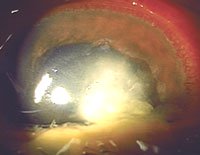Lessons learned from contact lens-related fungal keratitis cases
While investigators search for causes, the recent spate of infections should serve as a wake-up call to contact-lens users, physicians and industry.
![Dennis S.C. Lam, FRCS, FRCOphth [photo]](/~/media/images/shared-images/lam_70_90_25563.jpg) Dennis S.C. Lam |
Soft contact lens use is a risk factor for fungal keratitis and sporadic case reports of Fusarium have been published. However, studies from India, Hong Kong, and Singapore have reported an overwhelming predominance of bacterial infections in contact lens users. In patients with fungal keratitis, contact lens wear is a risk factor in 5% to 29% of cases, and except for a study from India in which Aspergillus was the most common organism; in Hong Kong, Singapore, Philadelphia and Florida, the commonest organism was Fusarium.
The recent reports of clusters of Fusarium in contact lens users in Hong Kong, Singapore, Malaysia, and the United States appear to have Bausch & Lomb’s ReNu with MoistureLoc multipurpose lens cleaning solution as a disproportionately common factor. The company has recommended that consumers not use that solution while investigations into these episodes are ongoing. Distribution of the product has been halted in Hong Kong, Singapore and the United States. The Singapore Ministry of Health has recommended that consumers stop using all ReNu brand multipurpose contact lens solutions for the time being.
The U.S. Centers for Disease Control has not reached any definitive conclusions about the source of the infections. The causes for this recent increase are as yet unclear. Fusarium is an opportunistic agent. A breach in the corneal epithelium is usually required for infectious keratitis in healthy eyes, and contact lens use can result in corneal microtrauma. Fungal colonization of contact lenses and their cases has been described in the past, and the water content of the lens may be a factor that promotes adherence. Given the ready availability of the agent (fungus), the predisposing event (contact lens-related trauma), and the host (30 million soft contact lens users in the United States alone), it is perhaps surprising that fungal keratitis in this scenario is not common – until the present episode.
Locating the cause
Why then this recent increase in incidence? One possibility is a mutated strain of Fusarium that is resistant to the antiseptic agent in the contact lens cleaning solution – considering that this is a widespread event in different continents, and that at the moment appears to occur predominantly with one cleaning solution – this theory has to be proven in specimens isolated from patients. The ReNu MoistureLoc solution is a variation of the earlier product and incorporates alexidine as the antiseptic instead of Dymed.
Because standard testing protocols against Fusarium with the newer agent have been shown to be effective prior to U.S. FDA approval, is it likely that this change is responsible? The new cleaning regimen does not insist on lens rubbing, and whether this is important in the context of a colonized contact lens or carrying case is unclear. The product insert recommends a minimum of 4 hours contact, with at least 3 mL of the solution – are these conditions being violated in actual use? Finally, is there some generic defect in the manufacturing process? These and other questions are being studied intensively by the company and other agencies.
|
|
Images: Lam DSC |
Wake-up call
For the patients, this is a wake-up call to follow good hygiene practices when using contact lenses. For the doctors, it emphasizes the need to maintain a high index of suspicion when contact lens users present with corneal infiltrates. For the industry, it is a reiteration that despite the stringent tests and conditions that are met prior to product approval, real-life use is often different, and hence the need for constant product monitoring – with efficient systems that anticipate crises and back-up plans to deal with them.
For all concerned, while it is unfortunate that the organism responsible for the keratitis is one of the hardest to treat, the lessons from this episode indicate that constant vigilance is required when dealing with patients and their problems, that there must be processes to help sound early warnings, and that as a community we must be prepared to act on these warnings to minimize damage. Blame and responsibility can follow once the initial firefighting measures have been instituted to contain the spread. Finally, as we struggle to control the fall-out from this episode, this is a sobering reminder that in medicine, the surgeon (and the company) is only as good as the last operation (or product).
For more information:
- Prof. Dennis S.C. Lam, MD, FRCS, FRCOphth and Srinivas K. Rao, DO, DNB, FRCSEd, can be reached at the Department of Ophthalmology & Visual Sciences, The Chinese University of Hong Kong, Hong Kong Eye Hospital, Kowloon, Hong Kong, People’s Republic of China; e-mail: dennislam8@cuhk.edu.hk.
References:
- Choi DM, Goldstein MH, Salierno A, Driebe WT. Fungal keratitis in a daily disposable soft contact lens wearer. CLAO J. 2001;27:111-112.
- Chowdhary A, Singh K. Spectrum of fungal keratitis in North India. Cornea. 2005;24(1):8-15.
- Foroozan R, Eagle RC Jr, Cohen EJ. Fungal keratitis in a soft contact lens wearer. CLAO J. 2000;26:166-168.
- Gray TB, Cursons RT, Sherwan JF, Rose PR. Acanthamoeba, bacterial, and fungal contamination of contact lens storage cases. Br J Ophthalmol. 1995;79:601-605.
- Houang E, Lam D, Fan D, Seal D.Cornea. Microbial keratitis in Hong Kong: Relationship to climate, environment and contact-lens disinfection. Trans R Soc Trop Med Hyg. 2001;95(4):361-367.
- Lam DS, Houang E, Fan DS, Lyon D, Seal D, Wong E; Hong Kong Microbial Keratitis Study Group. Incidence and risk factors for microbial keratitis in Hong Kong: Comparison with Europe and North America. Eye. 2002;16:608-618.
- Rosa RH Jr, Miller D, Alfonso EC. The changing spectrum of fungal keratitis in south Florida. Ophthalmology. 1994;101:1005-1013.
- Sharma S, Gopalakrishnan S, Aasuri MK, Garg P, Rao GN. Trends in contact lens-associated microbial keratitis in Southern India. Ophthalmology. 2003;110:138-143.
- Tanure MA, Cohen EJ, Sudesh S, Rapuano CJ, Laibson PR. Spectrum of fungal keratitis at Wills Eye Hospital, Philadelphia, Pennsylvania. Cornea. 2000; 19:307-312.
- Wong TY, Fong KS, Tan DT. Clinical and microbial spectrum of fungal keratitis in Singapore: A 5-year retrospective study. Int Ophthalmol. 1997;21:127-130.
- Wong TY, Ng TP, Fong KS, Tan DT. Risk factors and clinical outcomes between fungal and bacterial keratitis: a comparative study. CLAO J. 1997;23:275-281.
- Yamamoto GK, Pavan-Langston D, Stowe GC 3rd, Albert DM. Fungal invasion of a therapeutic soft contact lens and cornea. Ann Ophthalmol. 1979;11:1731-1735.


